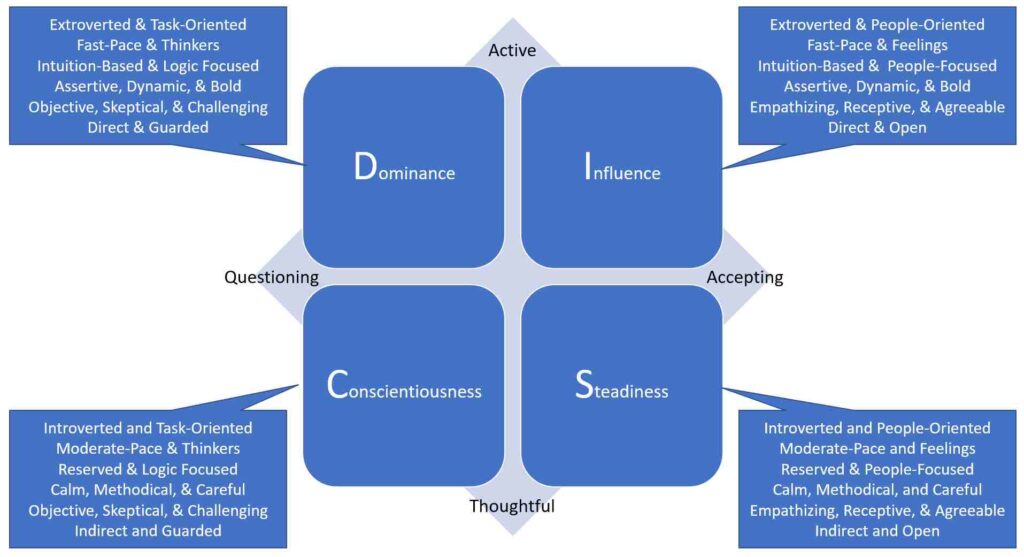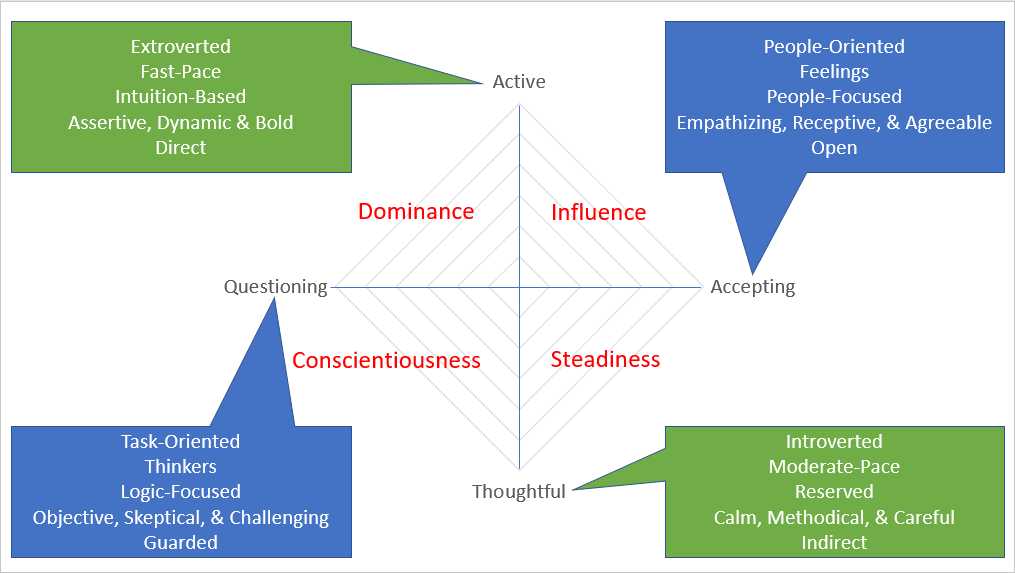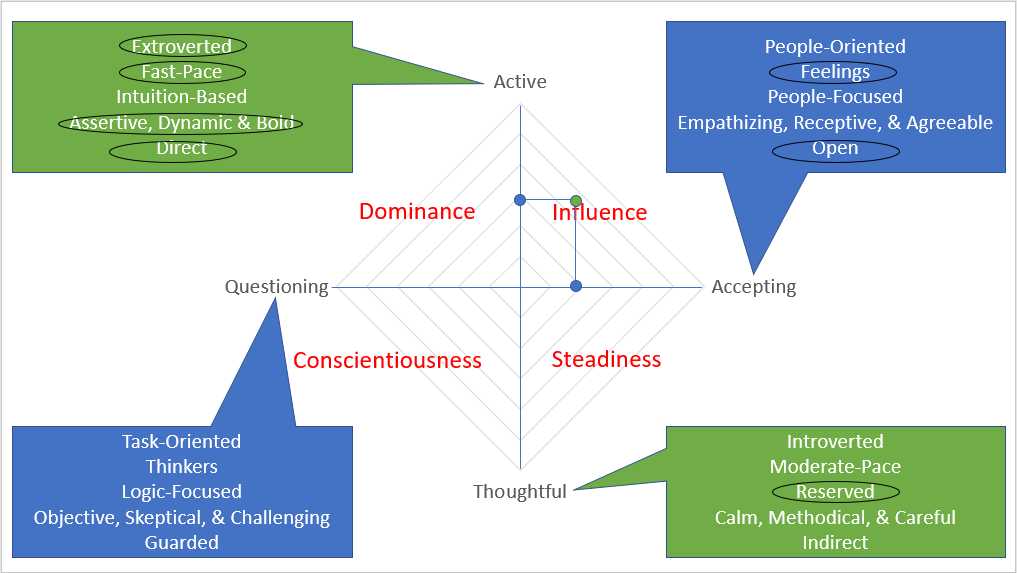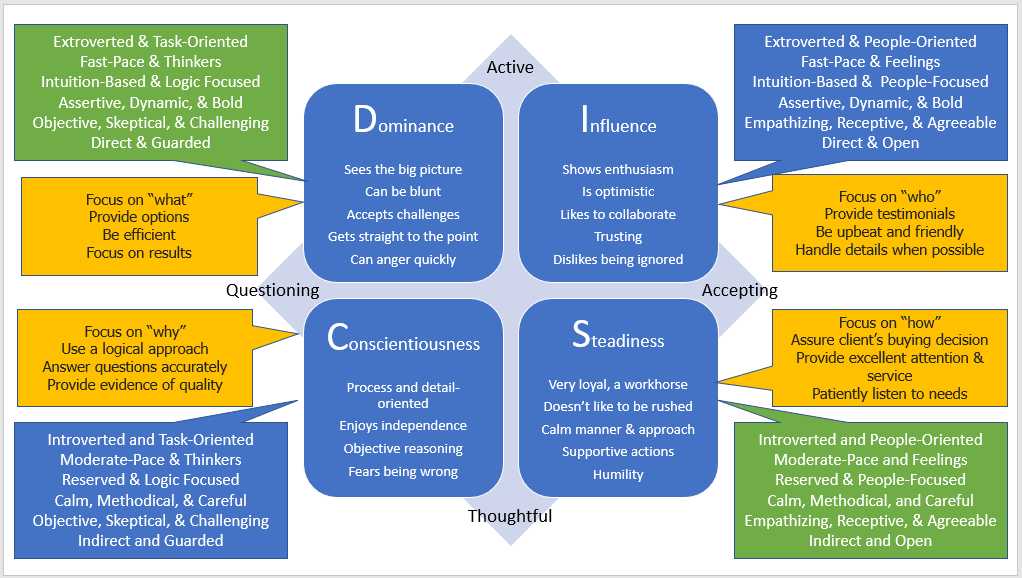Selling is at the heart of every small business. Most business owners simply wing it when it comes to sales. However, having a greater understanding of the psychology behind the selling process shows emotional intelligence and can make the difference between success and failure. Understanding a prospect’s or customer’s DISC profile is one of those concepts that small business owners should really grasp if they want sales success.
Selling is all about relationships. How competent a salesperson is at initiating and retaining customer relationships is a decisive factor in the success of a small business as a whole.
From a simple business to consumer (B2C) one-time service-based transactional, such as selling a landscaping solution, to selling complex business to business (B2B) products and support, being able to assess a prospect’s or customer’s psychological needs can make the difference between creating a lifelong customer or one that will tell their friends and family to avoid your small business like the plague.
Recognizing a prospect’s or customer’s DISC profile is a skill that can be incorporated into any sales system. The idea behind being able to recognize a person’s primary DISC profile is to help the salesperson become more self-aware and behaviorally flexible to better communicate and build trust.
Carl G. Jung first proposed four primary functions of consciousness. Later, William Moulton Marston identified the four primary personality types that correspond to different behavioral responses, which gave rise to the DISC behavior assessment.

DISC is an Acronym:
- D for Dominance
- I for Influence
- S for Steadiness
- C for Conscientiousness
Before we get into the definitions of each of the four DISC profiles, it is important to recognize the relationships that form the DISC profile quadrants. Behavioral responses can be applied along two primary axes. Energy is measured along the “Y” or vertical axis and Perception of the environment is measured along the “X” or horizontal axis. Using a series of attributes, you can plot a prospect or a customer based upon where they fall along the two axes, which will identify their primary DISC profile. Knowing the prospect’s or customer’s DISC profile will tell you what they value and provide you with a list of sales tactics to which they will be more responsive.
Assessment of Energy – “Y” Axis
“Are they quick to action and prone to making gut decisions, or more cautious and want to move at a more methodical pace?”

Active Energy
The top two quadrants labeled “D” and “I” represent people who are more extroverted by nature. They tend to operate at a faster pace and rely heavily on their intuition to make decisions. They are often characterized as assertive, dynamic, and bold. Traditional explanations of these top two quadrants suggest that these people perceive themselves as more powerful than the environment. Because of this perception, they tend to exert efforts to change their circumstances. They tend to follow their gut and prefer to move quickly through tasks.
People in the top two quadrants also tend to be more direct and demonstrate more control and assertiveness over information and situations.
It’s also about the level of control and assertiveness the person displays.
Thoughtful Energy
The bottom two quadrants labeled “C” and “S” represent people who are more introverted by nature. They tend to be more reserved and prefer to move at a more moderate pace. They are often characterized as calm, methodical, and careful. Traditionally, these people are thought to perceive themselves as less powerful than the environment, and thus they are more inclined to adapt to existing circumstances.
People in the bottom two quadrants also tend to be more indirect and demonstrate less control and assertiveness over information and situations.
“Do they prefer to jump into action immediately (Active) or do they prefer to take a more methodical approach (Thoughtful)?”
“Do they make decisions based on their gut instinct (Active) or would they rather spend time researching before making a decision? (Thoughtful)”
Assessment of their Environment – “X” Axis
“Do they challenge new information to make sure it’s correct? Do they speak their mind even if they know it might affect someone? Or do they generally agree with what someone tells them, and prefer to maintain a relationship over challenging someone about their belief?”
Questioning their Environment
The left two quadrants labeled “D” and “C” represent people that are more task-oriented by nature. They tend to be thinkers and are more focused on logic. They are often characterized as objective, skeptical, and challenging. A traditional explanation of these characteristics is that these people perceive the environment as antagonistic. In other words, they instinctively refuse to trust people and ideas until these outside elements have been thoroughly vetted. They tend to lean towards building an objective opinion on both people and the information they hear.
People in the left two quadrants also tend to be less transparent and more guarded about themselves and others.
Accepting Their Environment
The right two quadrants labeled I and S represent people that are more people-oriented by nature. They tend to rely more on feelings and are people-focused. They are often characterized as empathizing, receptive, and agreeable. Traditionally, they are said to see the environment as being aligned with their interests. In essence, they are prone to view people and ideas around them favorably and are thus inclined to trust them. They are more open to new ideas and receptive towards new people.
People in the right two quadrants also tend to be more transparent and open about themselves and others.
“When they are at work, do they prefer to ensure that the task gets done (Questioning) or that everyone has a chance to weigh in on the best course of action (Accepting)?”
“When they hear new information, are they more likely to challenge it to ensure that it’s correct (Questioning) or do they generally believe what someone tells them if they feel it comes from a reputable source (Accepting)?”

With a basic understanding of the DISC axes consider what you know about the prospect or customer and circle the attributes they exhibit. Count them up and plot them on the “X” and “Y” axis.

For example, if they have four Active attributes and one Thoughtful attribute, place a mark three points up from the center in the “Y” axis (4-1=3). Do the same for the “X” axis. The Intersection of these 2 points should identify the prospect’s or customer’s primary DISC Profile.
What follows is a more descriptive explanation of each of the four DISC profiles and the sales tactics that should prove most successful.
Dominance DISC Profile
The dominant profile has a primary need for achievement, which means someone with this profile is only going to call you if they need something. They’re not going to call you to chit-chat.
The prospect or customer in the dominance profile is direct, firm, and strong-willed. The person places emphasis on accomplishing results, the bottom line, and confidence. People in the dominance style focus on problems and challenges and tend to be direct and guarded in their relationships. They also prefer to move at a faster pace and are highly task-focused. The following attributes describe prospects and customers in the dominance profile:
- Sees the big picture
- Can be blunt
- Accepts challenges
- Gets straight to the point
- Can anger quickly
Selling to the Dominance DISC Profile
When selling to the dominance profile, don’t bog them down with details or excessive socializing – get to the point. Focus directly on how your product or service can help them achieve their goals. Emphasize the results you can help them obtain, while always letting them feel they are in charge. In other words, don’t waste their time. Make your sales presentation directly and meaningful aimed at helping them achieve their objectives.
Do
- Focus on “what”
- Provide options
- Be efficient
- Focus on results
Don’t
- Assume without getting an opinion
- Over socialize
- Emphasize unnecessary details
- Waste time
Influence DISC Profile
The influence profile has a primary need for recognition of their ideas. Too often, they want to share an idea but nobody listens.
The prospect or customer in the influence profile is outgoing, enthusiastic, and optimistic. The person places emphasis on influencing or persuading others, openness, and relationships. People in the influence style focus on people and contacts and tend to be direct and open in their relationships. They also prefer to move at a faster pace and are very people-focused. The following attributes describe prospects and customers in the influence profile:
- Show enthusiasm
- Are optimistic
- Like to collaborate
- Trusting
- Dislike being ignored
Selling to the Influence DISC Profile
When selling to the influence profile, match your pace and presentation to their energetic approach. Be friendly and sociable – let them know you like them personally. When appropriate, take them to lunch. You need to provide testimonials and personal stories on how other people have responded to your company’s product or service. Show enthusiasm for the benefits your product or service can provide. Also, make sure you support the individuals by providing whatever detailed follow-up work is necessary; don’t ask them to do it. Make it easy for them to buy from you.
Do
- Focus on “who”
- Provide testimonials
- Be upbeat and friendly
- Handle details when possible
Don’t
- Emphasize on technicalities of the product
- Be overly formal and reserved
- Add to client’s workload
- Leave decisions unclear
Steadiness DISC Profile
The steadiness profile has a primary need for relationships. They are people-oriented and are the glue that keeps the teams going.
The prospect or customer in the steadiness profile is even-tempered, accommodating, and patient. The person emphasizes cooperation, sincerity, dependability, and consistency and tends to be indirect and open in their relationships. They prefer to move at a slow or moderate pace and are very people-focused. The following attributes describe prospects and customers in the steadiness profile:
- Very loyal, workhorses
- Don’t like to be rushed
- Calm manner & approach
- Supportive actions
- Humility
Selling to the Steadiness DISC Profile
When selling to the steadiness profile, you must listen to them. They need to feel you understand their needs. Assure the individuals that you and your organization are customer and service-oriented. Just don’t push them into quick buying decisions. Show that you’re interested in a long-term relationship with their company and that they can depend on you whenever necessary. The steadiness style customers are more loyal to you when other vendors come knocking on their door.
Do
- Focus on “how”
- Reassure the client in his buying decision
- Provide excellent attention and service
- Patiently listen to their needs
Don’t
- Rush client into quick buying decisions
- Forget to regularly follow-up
- Have an “I don’t care” attitude
- Be abrupt or fast
Conscientiousness DISC Profile
The conscientiousness profile has a primary need for accuracy. They will Google everything you say. They need to check out everything for themselves just to make sure.
The prospect or customer in the conscientiousness style is analytical, reserved, and precise. The person emphasizes quality, accuracy, expertise, and competency and tends to be indirect and guarded in their relationships. They prefer to move at a slow or moderate pace and are highly task-focused. The following attributes describe prospects and customers in the conscientiousness profile:
- Process and detail-oriented
- Enjoy independence
- Objective reasoning
- Fear of being wrong
Selling to the Conscientiousness DISC Profile
When selling to the conscientiousness profile, make sure you have all your facts straight. You’ll need to answer analytical questions, showing references where possible. These individuals don’t need you to socialize with them – they don’t want you to. These people want you to provide detailed information to make a correct buying decision. Then, they will thoroughly assess your information before coming to a conclusion. Be slow-paced and formal in your approach with them – don’t become overly enthusiastic or animated. Focus instead on facts, logic, and detailed analysis.
Do
- Focus on “why”
- Use a logical approach
- Answer questions accurately
- Provide evidence of quality
Don’t
- Be overly enthusiastic or social
- Be unprepared or lack product knowledge
- Appear disorganized
- Rush decision-making

How can you employ your knowledge of the DISC profiles to improve your sales success?












